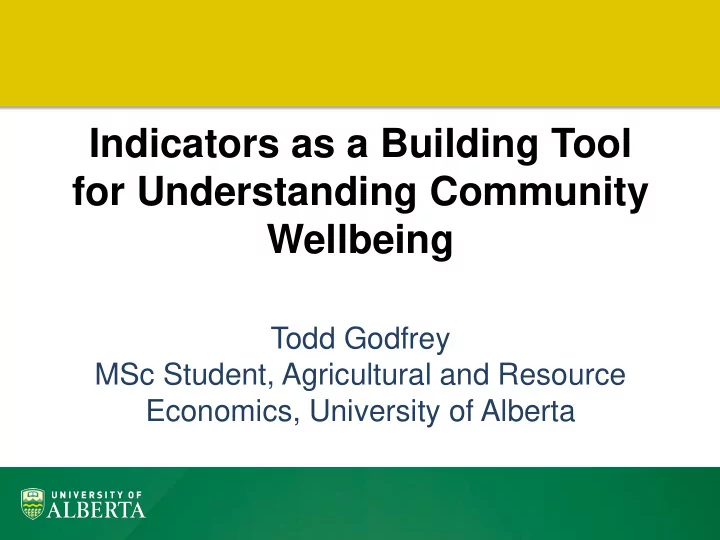

Indicators as a Building Tool for Understanding Community Wellbeing Todd Godfrey MSc Student, Agricultural and Resource Economics, University of Alberta
A Changing Arctic Climate change in the Arctic. • • Hinzman et al., 2005; Ford and Smit, 2004. Growing global population and economy with a • stronger connection to the Arctic. • Anderson et al., 2006. Increased resource development in the Arctic. • • Chance and Andreeva, 1995. Need for research on sustainable natural resource • development in the Arctic.
Development Economics Literature Faltering economic growth in Sub Saharan Africa due to • geographical, institutional, and other challenges. • Bloom, Sachs, Collier, and Udry, 1998. BRIC countries (Brazil, Russia, India, China) as fast growing • powers of today’s world economy. • Bosworth and Collins, 2008. • Brainerd, 1998. Many Arctic communities can be thought of as developing • economies, with their own set of challenges Little economic research has been done for these areas. •
Research Objective Develop a framework for understanding • relationships between economy and wellbeing. • Looking at these relationships for demographic groups all across Canada. Including a focus on Arctic communities, with the Inuvialuit • Settlement Region as specific case study. oag-bvg.gc.ca
What Do Economists Mean by Development? • Economic Development is not only economic growth • Growth: sustained improvement in the level of real per capita income. • Development is simply the process of improving the quality of all human lives.
Amartya Sen’s “Capability” Approach Poverty cannot be properly measured by income. • What matters for well-being is not just the commodities • consumed, but what use the consumer can and does make of commodities. • For example, a book is of little value to an illiterate person. Looking at real income levels, or even the levels of • consumption of specific commodities, cannot suffice as a measure of well-being. • Developing economies may not be able to transform increases in production into higher standards of living. • e.g. Greater production and greater environmental degradation: what is the “net” effect?
An “Empirical Approach” Use large datasets to examine different attributes of • well-being. • Why are large datasets useful? • See the big picture in larger populations, and comparisons across smaller populations. • Provides evidence on how people’s lives are changing, and can measure these changes. • Look at a relationships between many different indicators. • Limitations: • Data may not contain enough detail. • Challenging to get data to show us what is happening.
Three Important Components of Wellbeing: Health • • “Better Health is central to human happiness and well - being.” – World Health Organization. Education • • “Education that is relevant and purposeful has the power to transform people’s lives.” – United Nations Educational, Scientific and Cultural Organization. • Income/consumption • “Richer, better -educated people live longer than poorer less-educated people.” – NBER. • These are also used in the UN’s Human Development Index. To build our framework we will pull data from large datasets to measure • these components and their socioeconomic determinants.
Data Available to Examine Economic Development in the Arctic 1. Canadian Community Health Surveys • Approximately 240,000 respondents for Canada-wide analysis. 2. Aboriginal Peoples Surveys • Approximately 10,000 respondents for Inuit Nunangat. 3. Inuit Health Survey • Approximately 360 respondents for the Inuvialuit Settlement Region. naho.ca
Analytical Framework (Two-stage approach) i) Estimate a system of equations for our three components of • wellbeing. Health = f(X, Z1) + error Income = f(X, Z2) + error Education = f(X, Z3) + error Equations use socioeconomic indicators that affect all aspects of wellbeing (X) and those that are specific to each component of wellbeing (Zs). ii) Estimate a life satisfaction model to balance the effects of X and • Zs on general wellbeing. Life Satisfaction = β 0 + β 1 Ĥ + β 2 Î + β 3 Ê + error The RHS variables of this model are predicted values that incorporate information from all socioeconomic variables in step i).
What Will This Tell Us? Learn which socio-economic indicators have negative or • positive effects on the three components of wellbeing. Learn the socio-economic channels through which • indicators have an effect on wellbeing, and whether this effect will be positive or negative overall. Be able to measure these effects to implement effective • policies. • For example: resource development may have • A positive impact on income/consumption • A negative impact on health • What is the overall effect?
Next Steps of Research • Continued collection of micro-data will enable further research on the development of Arctic economies. Irc.inuvialuit.com
Recommend
More recommend